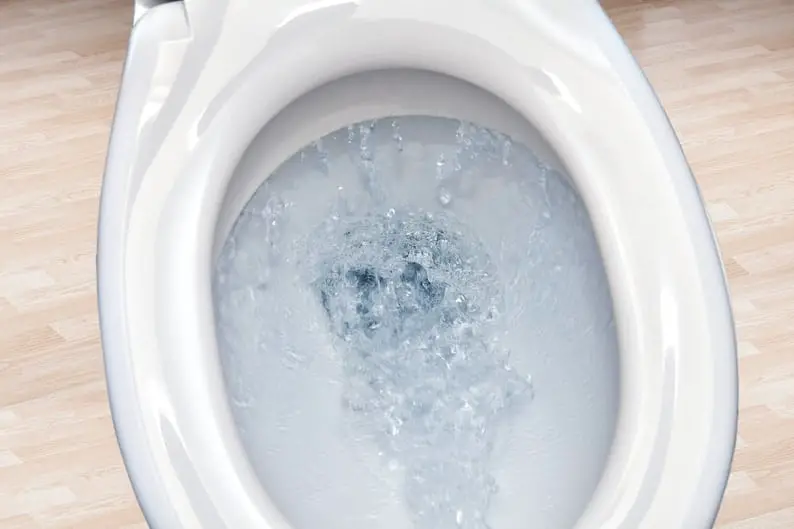How Much Water Does a Running Toilet Use?

Having a functional toilet is not only important but mandatory for living. When you are using a toilet normally, you should expect to use 5 to 15 gallons of water per person, per day, depending on how much you use the toilet.
If you start to notice your usage is suddenly a lot higher on your water bill., it may be a sign that your toilet is running.
If you have a running toilet, it can waste 4.5 gallons of water per minute. If this sounds like a lot, that is because it is! It is almost 300 gallons per hour or 6,480 gallons per day). Not only is this terrible for the environment, but it can increase your water bill by almost $60 per day!
The cause of most leaks is due to a part in your toilet. When toilets get older, the parts do too. In these cases, you will need to replace the parts and your water usage should go back to normal. The only trouble is you will need to figure out what part is not working properly first.
The good thing about your toilet is that all of these parts are affordable and easy to replace. Sometimes it is only necessary to change out one part, and you will immediately fix the problem.
One trouble you may run into is that you may replace the wrong part in hopes to fix a problem. This is simply a waste and then you might need to reinvestigate the reason for your trouble. Additionally, you may find that some of these parts are quickly worn away by different toilet cleaners. Although you would not think it, chlorine can be enough to wear down flappers.
When you have a running toilet it is actually considered to be a wide-open flapper. The causes of a running toilet may be because the flapper cannot close at all. This is due to the flush valve holding it open. This will allow water to constantly run from the tank to the bowl, and then down the drain.
If you have a leaking flapper, this will be caused by your flapper simply getting old. Leaks can also be caused by small pieces getting into your tank and slopping the flapper and the flush valve. This causes the water in the tank to leak into the bowl. As compared to a running toilet, a leaking flapper can waste up to 200 gallons of water per day. This can end up increasing your water bill by up to $50 per month.
Sometimes the fix for a wide-open flapper (a runny toilet) can be extremely simple. All you need to do is jiggle the handle. If this does not work, you can also turn off the water, and turn it back on each time you need to flush it. Although these methods work, there is a bit of a better option to fully fix your running toilet.
Begin by pushing down on the flapper. You can do this with a stick. Do this while you hear the water running, and listen for it to stop running when you press down.
If the water does stop when you push down, it means that your flapper is not sealing properly. You will need to replace it.
You will now need to check the fill tube length. Cut it back so it’s at least half an inch above the waterline.
Start by flushing the toilet to look for a fill valve leak. You can lift the toilet float arm while the tank is filling. If the water stops, then you know you have an issue.
To stop the tank from filling further than ½-1 inch below the top of the overflow pipe, you can bend or adjust it. If the fill valve still leaks, you will need to replace it.
After once again turning off the water supply, fulling flushing the toilet, and removing any water from the tank, it is time to disconnect the water supply line. Unscrew the fill valve locknut and lift out the old fill valve to get it ready for the new one.
If you have recognized an issue with your fill valve, then you will need to replace it. Do this by inserting the new fill valve in to the tank. Follow the instruction sheet on the packaging. Tighten the locknut slightly tighter than what you would do with your hand (about a half turn).
When the fill valve is at its maximum height, the overflow pipe should not be higher than the critical level mark. If this is the case, then you will need to shorten the overflow pipe with a hacksaw. Make sure it is one inch lower than the critical level mark on the fill valve.
Take one end of the new fill tube. You will need to attach one end to the valve nipple, but the other end to the angle adapter (this should have come with your tube)
Put the angle adapter on the overflow pipe, and finish this by attaching the flapper chain to the flush lever. Then turn on the water and flush your toilet to test it.
Yes, if you have a slow leak from your running toilet, you may only waste up to 30 gallons per day. This is still a lot, bu it a lot less than 250!
Your toilet as a whole can last up to 50 years. Having said that, you may not want to keep your toilet for half of a century. Instead, 15-20 years is a good amount of time to keep a toilet, and you can replace your toilet seat every 5-8 years.